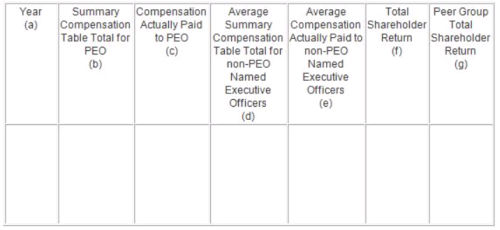On April 29, 2015, the Securities and Exchange Commission (SEC)
voted 3-2 to propose new rules requiring companies to disclose the
relationship between executive compensation "actually
paid" and the company's "financial performance."
The proposed rules implement Section 14(i) of the Securities
Exchange Act of 1934, as added by Section 953(a) of the Dodd-Frank
Wall Street Reform and Consumer Protection Act. These disclosures
would be required to be included in proxy or information statements
in which executive compensation disclosure is currently required
pursuant to Item 402 of Regulation S-K.
The pay-versus-performance rules are one of four governance and
executive compensation-related provisions applicable to public
companies under the Dodd-Frank Act that remain to be adopted by the
SEC. Three of the four (pay-versus-performance, hedging policy and
pay ratio) have now been proposed, leaving only the clawbacks
rulemaking to be proposed. While not as controversial as the pay
ratio rulemaking, pay-versus-performance nonetheless will bring
with it challenges for companies subject to the new disclosure
requirements, not to mention contribute to the ever-expanding
length of proxy statements.
The two key questions in the pay-versus-performance disclosure
mandate are what is compensation "actually paid" and what
is "performance." The SEC took the approach in the
proposal that compensation "actually paid" is the total
compensation that companies report in the summary compensation
table with adjustments for pension benefits and equity awards,
while "performance" must be measured by total shareholder
return (TSR). In addition to disclosing information about the
company's compensation and TSR, certain companies subject to
the new requirements also will be required to provide disclosure of
their peer companies' TSR.
Companies Subject to the New Disclosure
Requirements
The proposed rules would apply to all reporting companies except
for foreign private issuers (which are not generally subject to the
proxy rules), registered investment companies and emerging growth
companies (which were exempted from the statutory requirement by
Section 102(a)(2) of the JOBS Act). Smaller reporting companies
would be subject to the new requirements, but would receive certain
accommodations under the proposal.
Covered Executives
The proposed rules would require disclosure about the company's
named executive officers (NEOs) for each covered fiscal year.
Information for the principal executive officer (PEO) would be
presented separately, while an average would be provided for the
remaining NEOs. If multiple PEOs serve during a covered fiscal
year, the reported data would be an aggregation of those
individuals' compensation. Any other former executives who are
included in the summary compensation table as NEOs would be
included in the average reported for the remaining NEOs. In
discussing the proposal, the SEC noted its belief that requiring
average compensation for the non-PEO NEOs would make the
information more comparable year-to-year in light of the likely
variability in the composition and number of non-PEO NEOs over the
years for which disclosure is required.
Summary of New Disclosures
The proposed rules would add new paragraph (v) to Item 402 of
Regulation S-K, which would require the following tabular
disclosure for each of the company's last five completed fiscal
years (or three years in the case of smaller reporting companies)
in any proxy or information statement in which disclosure under
Item 402 is required:
PAY VERSUS PERFORMANCE

As reflected above, the required table must disclose the following for each covered fiscal year:
-
the PEO's total compensation, as reported in the summary compensation table in the proxy statement (presented on an aggregate basis if there was more than one PEO during the year);
-
the compensation "actually paid" to the PEO (the summary compensation table total compensation as adjusted for pension benefits and equity awards) (presented on an aggregate basis if there was more than one PEO during the year);
-
the average total compensation for the non-PEO NEOs (including any former executive officers required to be included in the summary compensation table);
-
the average compensation "actually paid" to non-PEO NEOs (including any former executive officers required to be included in the summary compensation table);
-
the company's cumulative TSR, using the definition of TSR included in Item 201(e) of Regulation S-K, which sets forth an existing requirement for a stock performance graph; and
-
the TSR of the companies identified in the peer group identified by the company in its stock performance graph or in its compensation discussion and analysis (CD&A).
Companies also would be required (using
the information provided in the table) to provide 1) a clear
description of the relationship between executive compensation
actually paid to the company's PEO and other NEOs and the
cumulative TSR of the company for the period covered in the table
and 2) a comparison of the company's TSR and the TSR of the
company's peer group.
In addition to being allowed to present three rather than five
years of information, smaller reporting companies also would not be
required to provide disclosure about peer group TSR because they
are not required to disclose an Item 201(e) performance graph or
CD&A.
Companies would be required to tag the disclosure in eXtensible
Business Reporting Language, or XBRL, which represents the first
time information in proxy or information statements would be
required to be tagged. This requirement would be phased in for
smaller reporting companies, so that they would not be required to
comply with the tagging requirement until the third annual filing
in which the pay-versus-performance disclosure is provided.
Calculating Executive Compensation "Actually
Paid"
The SEC stated that it recognizes companies currently follow
different concepts for "realized" and
"realizable" pay and that companies have not broadly
accepted one conceptual approach over another. To provide
comparability across issuers, the SEC's proposed rule sets
forth a calculation for amounts "actually paid."
Executive compensation "actually paid" would be
calculated using the total compensation amount that companies
report in the summary compensation table already required in the
proxy statement as a starting point, with adjustments relating to
pension benefits and equity awards. Companies would be required to
disclose the adjustments to the compensation as reported in the
summary compensation table.
Under the proposal:
-
Pension amounts would be adjusted by deducting the change in pension value reflected in the summary compensation table and adding back the actuarially determined service cost for services rendered by the executive during the applicable year. Smaller reporting companies would not be required to make adjustments in pension amounts because they are subject to scaled compensation disclosure requirements that do not include disclosure of pension plans.
-
Equity awards would be considered actually paid on the date of vesting and at fair value on that date, rather than fair value on the grant date as required in the summary compensation table. A company would be required to disclose the vesting date valuation assumptions if they are materially different from those disclosed in its financial statements as of the grant date.
Measure of Financial Performance
While Section 14(i) of the Exchange Act
does not specify how a company's financial performance is to be
measured, it requires financial performance to take into account
any change in the value of the shares of stock and dividends of the
company and any distributions of the company. To meet this
statutory requirement, the SEC has proposed to use TSR, as defined
in Item 201(e) of Regulation S-K, which is calculated by dividing
(i) the sum of (A) the cumulative amount of dividends for the
measurement period, assuming dividend reinvestment, and (B) the
difference between the registrant's share price at the end and
the beginning of the measurement period; by (ii) the share price at
the beginning of the measurement period. Issuers, other than
smaller reporting companies, must present comparative TSR
information for the same peer group used for purposes of Item
201(e) of Regulation S-K, or, a peer group used in the CD&A for
purposes of disclosing the issuer's compensation benchmarking
practices. For many companies, TSR is not the way financial
performance is generally measured. While the proposal would require
use of TSR, companies may supplement the required disclosure under
the proposed rule with other measures that they feel are better
suited to the company, so long as such measures are clearly
identified, not misleading, and not presented with greater
prominence than the required disclosure.
Subject to Say-on-Pay Vote
Because the proposed new disclosures would be provided under Item
402, the disclosures would be subject to the say-on-pay advisory
vote required under Rule 14a-21(a). In proposing the new disclosure
requirements, the SEC noted its belief that both the
pay-versus-performance and pay ratio provisions under the
Dodd-Frank Act were intended to provide shareholders with
information to help assess a company's executive compensation
when exercising their rights to cast say-on-pay votes, and that the
new pay-versus-performance disclosures will provide shareholders a
new metric for assessing a company's executive compensation
relative to its financial performance.
Phase-In of New Disclosure Requirements
The proposed rules would be phased in for all companies subject to
the new disclosure requirements. Companies other than smaller
reporting companies would be required to provide information on the
prior three years the first time the new disclosure is provided,
with an additional year of information provided in each of the two
subsequent annual proxy or information statements. Smaller
reporting companies would initially provide the information for two
years, with the third year to be added in their next annual proxy
or information statement. The timing of adoption of the final rules
will determine when the disclosure is first required, which could
be as early as the 2016 proxy season.
Comment Period
Comments on the rule proposal should be received by the SEC on or
before July 6, 2015. The proposing release includes 54 specific
requests for comment, as well as a general request for comment. In
addition to requesting comment on the various specific details of
the rule proposal, the SEC more generally requests comment on
whether the proposed rule strikes the appropriate balance between
prescribing rules to meet the statutory requirements of Section
14(i) while also allowing issuers sufficient flexibility to provide
the most useful information to shareholders, and whether the SEC
should permit a principles-based approach to the disclosures.
The content of this article is intended to provide a general guide to the subject matter. Specialist advice should be sought about your specific circumstances.






